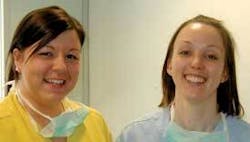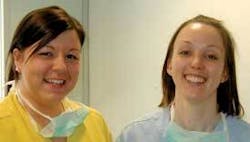Posh Brits and Dental Hygiene
by Lynne H. Slim, RDH, BSDH, MSDH
I can’t deny my fondness for the British. Not only did I live there in the early 1990s, but I also married into a British family and am constantly exposed to the British culture, which can occasionally seem strange and eccentric. My husband’s generation was very polite, reserved, and regimented. I never knew what “queuing” meant until I observed British culture and quickly learned that to queue means to stand in line in an orderly fashion. No pushing or shoving, no unnecessary chatter. When we lived in England, we decided to put William, our 12 year-old son, in an all boys secondary school. We took a lovely tour of the school our son would attend if accepted. The headmaster was very strict, and the students stood at attention when we entered a classroom. There was absolute silence too; you could have heard a pin drop in that classroom!
While living there about 13 years ago, I visited a dental practice in a local village and wanted to meet the dental hygienist on board. Unfortunately, this particular practice did not employ a dental hygienist. The dentist did not believe in preventive oral hygiene visits. He examined my kids, but did not recommend any preventive services. Granted, their dentitions were immaculate because of their conscientious RDH Mom, but I had hoped that dental hygiene services would be similar to those performed in the United States. At that time, I discovered that dental hygienists in England received only 20 or 30 minutes to assess and treat patients, and this convinced me that British dental hygiene was still in the dark ages.
A Return Visit To British Dentistry
This past April I decided to visit a rather “posh” dental practice in an upscale section of downtown Manchester (northwest England). I thought I’d update you on dental hygiene standards there. I paid a visit to St. Ann’s Dental Clinic. The clinic exceeded my expectations and I left wondering whether dental hygiene in the United Kingdom will surpass us one of these days!
Before I describe St. Ann’s, let me mention that RDH readers can take a virtual tour of the dental clinic by visiting the St. Ann’s Web site: www.stanns.co.uk/welcome.aps. Note the bright colors in the reception area and the practice’s commitment to excellence in dentistry, facial aesthetics and immunology to improve health. The clinical director, Dr. Paul Tipton, established St. Ann’s in 1986 as a private cosmetic dental practice but it has grown into one of England’s outstanding modern cosmetic practices.
Naturally, I visited St. Ann’s to meet their hygienist, Lisa, and talk to her about the oral hygiene care she expertly delivers to her patients. I arrived at St. Ann’s in mid-morning and the practice manager, Ged, welcomed me into the practice. The reception area struck me as quintessentially English, as patients were offered a “cuppa” (cup of tea) while waiting to be seen. I also had the privilege of meeting a gentleman named Simon who held the position of receptionist/operations manager. Simon has that typical, self-deprecating sense of humor that I find so common in the United Kingdom. He focused on my hairstyle (typical American foils) as a way to give me a compliment. I’ll take them any way I can get them and I enjoyed Simon’s modest and teasing ways.
The English have historically lived a very structured and orderly life, and I’ve recently noticed a great leap forward in society that has included a more relaxed and welcoming manner - different from what I experienced many years ago in English dental practices. I remember entering one such practice and immediately noticing, besides the cat curled up in front of a fireplace in the reception area, a receptionist who reminded me of an old English school marm, stern, unwelcoming and deliberately averting her eyes as I signed in.
Lisa received her dental hygiene diploma as part of military training and it took her two years to earn her diploma. She can administer local infiltration and block anesthesia and, unlike U.S. hygienists, she has a personal assistant called a dental nurse who sticks to her side like glue. Her modern operatory has a view of St. Ann’s outdoor shopping centre.
Unlike typical American dental hygiene protocol that includes supervised dental hygiene care coupled with a routine exam, hygiene appointments are unsupervised and completely separate from radiographic and restorative exams, which are scheduled on the dentist’s appointment book. (OK, wakey, wakey American general dental practices!) This makes a lot more sense logistically, and American hygienists would not have to wait patiently (or impatiently as the case may be, stomping our feet and pacing back and forth) if we adopted a similar system!
In July 1991, amendments were made to the government’s General Dental Council that provided written regulations to dental auxiliaries in 1986. The amendments removed the requirement of direct personal supervision and permitted dental hygienists to administer local infiltration anesthesia provided that the dentist was on the premises and had indicated the course of treatment to the dental hygienist in writing.
Lisa schedules her own patients and she typically schedules a two-hour appointment for “detox,” their name for scaling and root planing. The appointment includes a pre- and post-mouth rinse (chlorhexidine gluconate), a 10-day post-detox mouth rinse (chlorhexidine gluconate) and an adjunctive antimicrobial gel called Corsodyl applied during initial therapy. Corsodyl is a chlorhexidine gluconate-based gel available in Europe. Lisa performs piezo ultrasonic instrumentation and she frequently recommends interdental brushing with a brand of interdental brushes that were designed for hygienists by a hygienist! The inserts come in different diameters and use a slightly different design than the ones we use in the U.S.
St. Ann’s is essentially a fee-for-service practice but offers some creative in-house financing. For example, a Bronze level service plan at £12.00 a month includes a dental/oral cancer examination and a 30-minute hygiene appointment. Thirty minutes, though obviously inadequate for dental hygiene professionals here in the U.S., is probably equivalent to a 45 to 50 minute American dental prophylaxis appointment since Lisa:
- Functions with her own personal assistant at her side
- Does not have to take radiographs; and
- Does not have to wait on a dentist to examine the patient.
At the high end of the service plan, £47.40 a month entitles a patient to two dental/oral cancer exams and two 45-minute hygiene appointments.
St. Ann’s offered a variety of cosmetic and restorative dental services often found in American spa-like cosmetic dental practices such as lip enhancement and manicures/pedicures, but I was particularly struck by a health service offered by a biochemist named Dr. Joe Smarda. Homeopathic remedies are offered to patients and Dr. Smarda calls his approach to treating certain chronic illnesses like stomach problems, weight balancing and hay fever, to name a few, “Applied Immunology.” Dr. Smarda’s approach involves probiotics, which restore the normal gut balance following a course of antibiotics, and an overall emphasis on restoring intestinal health. All treatments performed are based on natural medicines and supplements that are administered to improve immune system function. Dr. Smarda’s unconventional medical philosophy flies in the face of many of the messages and therapies produced by conventional Western medicine. Here in the U.S., this alternative approach to medicine is growing increasingly popular and chiropractors and homeopaths offer similar services.
Dental hygienists in England also work in National Health practices (subsidized by the government) and many routine oral hygiene appointments are still scheduled at 20- or 30-minute intervals. Lisa, in private practice, is compensated on a percentage basis accounting for approximately 35 and 45 percent of her production and I assume that her personal assistant is paid for by the dental practice.
As I review the history of dental hygiene in England and compare it to dental hygiene on American soil, several thoughts come to mind. The British Dental Hygienists’ Association (BDHA) celebrated its golden jubilee for 50 years of service in 1999 and is the sole representative organization for all British dental hygienists. A London hygienist named Barbara Young sent me a written copy of the history of BDHA and I devoured it from cover to cover. Although dental hygiene began in England, as in the States, as an “auxiliary” role, the General Dental Council in the UK is committed to serving more members of the UK population and a review group recently gave its vision of the future of dentistry in the UK. This review group still views the dentist as the leader of the dental care delivery team but recognizes the need for dental hygienists as dental therapists. Updated dental hygiene curricula in the UK now include the placement of restorations in deciduous and permanent teeth, placing crowns and extracting deciduous teeth under local anesthesia.
For more information, visit www.bdha.org.uk, and you will also notice that the association’s name has changed to the British Society for Dental Hygiene and Therapy (BSDHT).
To me, a huge breakthrough for British hygienists and other European practitioners is the ability to work without direct personal supervision and the separation of hygiene appointments from dental examinations with a dentist. Would I enjoy working in this environment in downtown Manchester at St. Ann’s Dental Clinic? You betcha, especially with a personal assistant to make my day less stressful and more patient-focused.
After saying my goodbyes to Lisa, Simon, Ged, and Lisa’s assistant, Becky, I left St. Ann’s feeling good about at least one UK hygienist’s full-time private practice employment. I returned to the pub around the corner and found my husband and friends deep in conversation, happy with their pints of English beer and reminiscing about bygone days. Caricatures of my husband and of his brother, Andrew, had been framed and placed on the walls of the pub about 10 years ago. Looking for them, I found my husband’s caricature first. It looked nothing like him but he’s proud of it nonetheless. UK hygienists should be proud of their accomplishments, too, and I believe that their future, like ours, looks very bright.
About the Author
Lynne H. Slim, RDH, BSDH, MSDH, is a practicing hygienist/periodontal therapist who has more than 20 years’ experience in both clinical and educational settings. She is also president of Perio C Dent Inc. (Perio-Centered Dentistry), a practice-management consulting firm that specializes in creating outstanding dental hygiene teams. Lynne is a member of the Speaking and Consulting Network (SCN) that was founded by Linda Miles, and has won two first-place journalism awards from ADHA. Lynne is also owner/moderator of a periodontal therapist yahoo group: http://yahoogroups.com/group/periotherapist. She can be contacted at [email protected].


